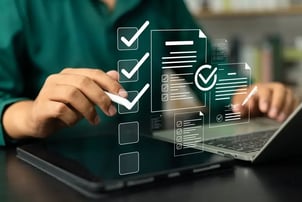This blog explores the benefits of RFP database response software and tips for making it effective for your business.
RFP Response Writing Challenges
Responding to Requests for Proposals (RFPs) is a time-consuming and resource intensive process. One of the biggest time-consuming challenges in crafting effective proposals is finding the right content.
These writing challenges can significantly impact the quality of your RFP responses.
- Knowledge Silos: Information may be scattered across different teams, departments, and systems. This makes it time-consuming to locate up-to-date information.
- Inconsistent Responses: Inconsistent content pulled from past proposals causes confusion, demonstrates questionable quality and lack of attention to detail.
- Lack of Standardization: Inconsistent formatting, grammar, and style makes the proposal appear unprofessional. And raises doubts about your ability to deliver.
- Outdated Information: Relying on outdated information can lead to irrelevant, inaccurate or risky information. It also requires more time to fix or update.
The Power of RFP Database Response Software
RFP response database software offers numerous benefits for organizations that respond to RFPs. By centralizing up-to-date content, this tool streamlines the writing process and saves significant time.
Don’t confuse an RFP response database with harvesting content from a variety of past proposals. While both methods involve reusing content, only the response database offers these key advantages;
- Faster Proposal Development: By reusing up-to-date content, teams can significantly reduce the time required to create new proposals without so many revisions.
- Flexible Content: Some database tools are flexible enough to include FAQs and boilerplate as well as past proposals and frameworks for unique responses.
- Improved Content Quality: Significant time savings means more time to tailor your proposal to specific client needs and goals for greater evaluation impact.
- Reduced Errors: Up-to-date content eliminates errors and inconsistencies that require more revisions, and might put the proposal or your business at risk.
- Faster Searches: When powered by AI, databases deliver fast, relevant suggestions based on requirements or queries.
- Content Maintenance: The same workflow that drives your proposal process drives a network of experts responsible for keeping content current.
Best Practice: Balance Reuse with Uniqueness
Remember, clients value original, tailored proposals that demonstrate your deep understanding of their needs. So, while leveraging content saves time, it’s important to maintain a balance of reuse and uniqueness and personalization. Especially if you are reusing content from a past proposal.
Here are some tips to ensure your proposals don’t stand out for the wrong reasons:
- Separate the reusable content from its original context.
- Replace the context with relevant insights and analysis.
- Infuse a real-life detail or anecdote to leave a lasting impression.
- Use client-specific language and reference their unique challenges and goals.
- Realign based on the evaluation criteria.
- Fold in your win themes to highlight what sets your organization apart.
Tips for RFP Database Response Set-up
A well-organized RFP response database can super-charge your proposal process. By carefully curating and maintaining your database, you can save time, improve quality and scale faster to volume demands.
Here we’ll explore the types of content to include in your database and strategies for maintaining it effectively.
Define Your Needs
Define your balance between reuse and uniqueness. What percentage of your proposals require unique responses vs tailored reuse? This will help you define the types of content you want to maintain. Work with your team to Identify the content contributors reach for most often, and document the gaps.
Prepare Your Content
To build a comprehensive RFP response database, you should consider a number of content types. Whenever possible, consider a modular approach; break down complex topics into smaller, more manageable, reusable components.
- Core: Company overview, mission and vision, values, history, milestones, financial information, awards and certificates. Methodologies, approaches, organizational structures and solution overviews.
- Boilerplate: Different types of executive summaries, standard paragraphs, section introductions, section conclusions and section transitions, legal and compliance statements.
- Proof: Detailed case studies, project descriptions, quotes, testimonials, endorsements, user scenarios, metrics, references, and use cases.
- FAQs: Frequently asked questions and answers about your company, solutions, technology, features and functions, and methodologies.
- Capabilities: Project team capabilities, biographies, resumes, and references..
- Frameworks: Models/structures that provide a logical framework for creating content that readers will understand and enjoy.
- Filing Structure: Some database solutions provide dynamic organization. This allows you to adjust organizational structures on the fly without moving documents.
Create a Maintenance Network
Sometimes, your reusable content may be static. For example, company overviews and team resumes are usually updated once a year. In other cases, your content might be dynamic. For example, solution, project, and client information might be updated more regularly.
Consider this as you establish your content maintenance protocols:
- Tap Creation: Find out where important information is created during a current process, like solution documentation. Embed content capture and updates as part of this process.
- Assign a Review Timeline: Determine what content is static vs dynamic and identify a reasonable review timeline for both. Best practice is to base this on an existing process with embedded experts.
- Establish an Expert Network: Involve experts already embedded in those processes. Best practice is to match the content updates with the expert who will use it for their proposal tasks.
- Plan to Fill the Gaps: Identify common content themes and group them into categories. Create a proposal watch list to identify creation and capture information.
The Xait Difference
RFP response databases save time by jump-starting your proposal writing effort. They streamline the process by providing fast access to reusable content. And they reduce the need to start from scratch on every RFP.
However, when it comes to the unique components of your proposal, response databases can be limiting.
That’s where Xait software provides a significant advantage. By combining an RFP response database, or content library, with co-authoring software, teams get the best of both worlds.
- RFP Response: Organize any number of content libraries, no tagging required.
- Co-Authoring: Write and review in-parallel and skip the pens down.
- Collaboration: Review and comment in-document for greater revision clarity.
- Workflow: Task workflow keeps your team and content up-to-date and in sync.
- AI-powered Suggestions: Get fast, relevant suggestions to jump-start your writing.
- Templates: Remain consistent with master documents and policy-based documents.
- Layout Template: Maintain formatting even when contributors use copy and paste.
- Management Tools: Proposal managers easily monitor progress and status.
- Enterprise Security: Protect sensitive information with granular permissions.
- Scalability: Automatically add newly written content to your stockpile for review,
By using a response database and co-authoring, you can streamline your proposal process and save significant time. This will help you create more high-quality proposals more quickly and stay ahead of the competition.
Remember, clients value quality content. No matter what content you start with, always organize it logically and tailor it to their specific needs and goals.












